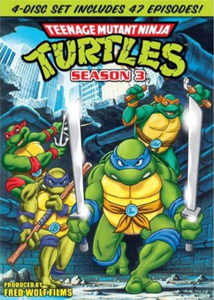“Now we’re cookin’!,” as Raphael might say. The 22nd episode often marks the end of a season in American TV measurements, but in the 47-episode “Teenage Mutant Ninja Turtles” Season 3 (1989), it’s still short of the halfway point. But it does mark the point when it gets quite good.
A fly in the ointment
The second Baxter-Stockman-as-Fly episode and the first two Casey Jones episodes mark an uptick in quality. “Return of the Fly” (22, written by Michael Reaves) is the series’ best episode up to this point. There’s a real sense of continuity and scope when Splinter senses they are being watched and Donatello suggests it might be the Rat King.
The writers have remembered both Baxter, who phases back into this timestream, and the Rat King (Townsend Coleman, mastering the voice that he hadn’t figured out on “Enter the Rat King”), who lives down the sewer tunnels a ways. He helps the Turtles find April, while still being weird and sinister, establishing himself as a wild card.

“Teenage Mutant Ninja Turtles” Season 3, episodes 22-29 (1989)
Syndicated
Episodes: “Return of the Fly” (22), “Casey Jones – Outlaw Hero” (23), “Mutagen Monster” (24), “Corporate Raiders from Dimension X” (25), “Pizza by the Shred” (26), “Super Bebop & Mighty Rocksteady” (27), “Beware the Lotus” (28), “Blast from the Past” (29)
Producer: Fred Wolf
Writers: Michael Reaves (22), David Wise (23, 25, 29), Michael Edens and Mark Edens (24, 26), David Carren and J. Larry Carrol (27), Doug Molitor (28)
The comedy stylings of Bebop and Rocksteady have never been funnier, as Reaves builds the gags around the self-help video they’ve been watching in their Technodrome quarters that resemble a ratty dorm room. Cam Clarke (Rocksteady) and Greg Berg (the backup Bebop, but quite good here) have a blast playing the duo’s stressed efforts at tolerating each other, drawing out the phrases “old pal” and “good buddy.”
Casey (finally) at the bat
“Casey Jones – Outlaw Hero” and “Corporate Raiders from Dimension X” (23 and 25, David Wise) belatedly bring Casey Jones (a much bigger character in the Mirage comics) to the cartoon, as per the request of Eastman and Laird.
The cartoon focuses only on the first dimension of Casey’s characterization – a head-busting vigilante who himself isn’t right in the head – but that’s fine. Pat Fraley (also great as Krang) blatantly impersonates Dirty Harry, and Wise gives Casey deliciously absurd one-liners like “Even appliances have to obey the law!”
“Outlaw Hero” mildly suffers from the plot of appliances attacking the city – something that happens with bizarre frequency on this show. But “Corporate Raiders” makes a case for being the series’ best episode, period. The idea of Casey applying for a white-collar job while wearing his hockey mask and lugging his bag of sports gear is funny in the way this show is always funny, but it goes that extra notch further.

What’s more, “Corporate Raiders” has actual commentary on office-drone life and corporatism that’s recognizable to adults and might even sink in for children. Shredder is of course behind the Octopus Inc. brainwashing scheme, yet there’s a sense of menace to the question of what the mysterious Grand Arising refers to.
A little more gender balance
Those are the three great episodes in this batch, but the others have plenty of talking points. The title character of “Beware the Lotus” (28, Doug Molitor) is among the five most notable female characters in “TMNT” lore as of 1989, behind April and Irma, and arguably Renet and Radical. She predates other female ninjas such as Lucindra, Karai, Pimiko and April-as-martial-artist.
Lotus Blossom and Leonardo become immediately smitten with each other while sword fighting. It’s not executed much better than the Mikey-Kala mutual crush, but it’s rather cute how the animators portray Leo’s love-struck expression.
In 1989, the idea of female action figures was a non-starter (Lotus finally got a figure via NECA this year), although it should be noted that neither tween boys nor girls cared much about characters’ gender in the Eighties. It’s possible those female characters would’ve sold if they were made in equal quantities (April certainly wasn’t a peg warmer; no one could find her). But perhaps because of a lack of any peg presence, Lotus’ significance in “TMNT” lore is underappreciated.
Weird Pizza, and weird toys
Toy-and-toon synergy generally clicks in this batch, though. “Pizza by the Shred” (26, Michael Edens and Mark Edens) has a particularly goofy Shredder scheme (he aims to attract the Turtles by opening Weird Pizza). But in a great action sequence (in conception more than animation), the baddies ride a Footski through the sewer and the Turtles unload on Foot Soldiers with the Double Barreled Plunger Gun and Retrocatapult while also riding in a Sewer Party Tube. And Shredder swipes the Neutrino Starcruiser, setting the stage for the Footcruiser.
“Super Bebop & Mighty Rocksteady” (27, David Carren and J. Larry Carrol) seems like it exists to be an action figure commercial, as the writers don’t have much for the robo-title-characters to do except say “Stomp Toitles!” But they wouldn’t become toys until 1993, under the names Robotic Bebop and Robotic Rocksteady. (There was also a Mighty Bebop, of no relation to this design.) The episode itself tries to be a comedy about the Channel Six team being mesmerized into acting like animals, but the humor never lands.
A slightly better episode that primarily aims for laughs is “Mutagen Monster” (24, Edens and Edens). As the title character is a giant bull, the episode exists for the sake of puns about bulls, steers, cows and ranching in general – and Raph and the gang take full advantage. The plot is stuck in the corral, though, so the romp is less fun than, for example, “20,000 Leaks Under the City.”
Wrapping up this batch is “Blast from the Past” (29, Wise), which today gains a double meaning because it’s a clip show. Flashback episodes are no longer necessary in an age when the whole series is at viewers’ fingertips. Splinter has amnesia so the Turtles tell him the story from Season 1. It’s a stark reminder of how outright good the animation used to be. One value of “Blast” is that you can watch it to get the origin story in 22 minutes instead of 110.
Even given “Blast from the Past,” at this point “TMNT” is moving forward rather than backward, acknowledging continuity, building the roster, trying slightly new plots (“Lotus” isn’t great, but the Krang vs. Shredder vs. Lotus vs. Turtles structure is fresh) … and of course introducing new action figures, vehicles and accessories.

